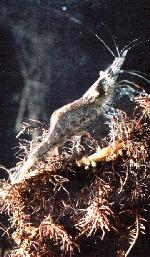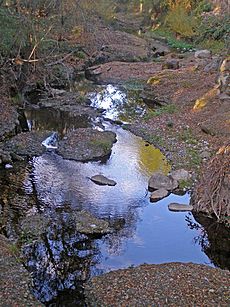Syncaris pacifica facts for kids
Quick facts for kids Syncaris pacifica |
|
|---|---|
 |
|
| Conservation status | |
| Scientific classification | |
| Kingdom: | |
| Phylum: | |
| Subphylum: | |
| Class: | |
| Order: | |
| Infraorder: | |
| Family: |
Atyidae
|
| Genus: |
Syncaris
|
| Species: |
S.pacifica
|
| Binomial name | |
| Syncaris pacifica Holmes, 1895
|
|
The Syncaris pacifica is a special kind of freshwater shrimp. It is an endangered species, which means it is at risk of disappearing forever. This shrimp lives only in a small area of northern California, USA.
You can find it in just 17 stream parts across Sonoma, Napa, and Marin Counties. This shrimp is often clear or see-through. Both male and female shrimp can change their color a lot. This helps them hide from predators using a clever type of camouflage. This ten-legged decapod is also known as the California freshwater shrimp. It is the only shrimp in California that lives in fresh water, not salt water.
S. pacifica is one of only four types of Atyidae shrimp found in North America. Scientists have studied the genes of these shrimp from different places. They found many clear genetic differences among these groups. This shrimp looks a bit like its ocean relatives. It can grow to be about 5 centimeters (2 inches) long.
Contents
What Does It Look Like?
The California freshwater shrimp is a crustacean with ten legs. It uses two main ways to hide itself. First, it is partly see-through. Second, it has special color cells called chromatophores. These cells are both inside and on the surface of its body.
Its Special Camouflage
The color cells are grouped together. Along with its see-through body, they help hide its shape. This makes the shrimp blend in with its surroundings. It looks like old, rotting plants under the water. California freshwater shrimp move very slowly. They are almost impossible to see among leaves and twigs in the water. They also hide among the thin, exposed roots of plants along stream banks.
Male and young shrimp are always clear or see-through. Female shrimp can be see-through too, but their color can range from dark brown to purple. Some females have a wide tan stripe on their back. Females can quickly change from a very dark, hidden color to almost clear. They do this by spreading out their color cells. Females are usually longer and have deeper bodies than males.
All shrimp in the Atyidae family have certain features that set them apart. These include their total body length and the size of their pincer-like claws. They also have tiny bristles (setae) at the tips of their first and second claws. The California freshwater shrimp has a short spine above its eye. Its second claw connects to its wrist (carpus) at an angle. These features help tell it apart from other shrimp in California. It can grow to have a body length of just over five centimeters (about 2 inches). This length is measured from its eye socket to the tip of its tail.
Where Does It Live?
We don't know exactly where Syncaris pacifica used to live. The land and climate have changed a lot over time. This has changed the paths of rivers along the Northern California coast. In the past, Syncaris pacifica might have lived as far north as the Klamath River.
But its habitat has shrunk a lot. This is mainly because of too much grazing by cattle. Also, chemicals have polluted the water. Now, it only lives in 17 stream parts in Sonoma, Napa, and Marin Counties. These stream parts are sometimes separated by damaged areas of the creek. This means the shrimp groups are split up, which is called habitat fragmentation.
The shrimp only live in streams that flow all year. These streams must be below 100 meters (330 feet) above sea level. They also need a gentle slope of less than one percent. The stream parts where they live can be grouped like this:
- Some streams that flow straight into the Pacific Ocean. These are in Marin and Sonoma Counties, including Tomales Bay.
- Sonoma Creek, the lower Napa River, Tolay Creek, and Petaluma River. All of these flow into San Pablo Bay.
- Some lower branches of the Russian River. These include the Laguna de Santa Rosa and some of its smaller streams like Blucher Creek.
How Does It Live?

California freshwater shrimp like streams that flow all year. They prefer areas with slow-moving water. In the summer, when there is little rain, the water flow can be very low. There might be larger pools. But in the rainy winter, these streams carry a lot of water.
Within a stream, S. pacifica prefers slow to medium-flowing pools. They also like glide areas with banks that hang over the water. They do not live in water that is even a little bit salty. However, they can survive for at least 13 days in 50% seawater. This might help them spread to new streams, as possibly happened in Olema Creek.
What It Eats
S. pacifica moves slowly and eats dead plants and other tiny bits of decaying matter. It eats small particles that currents carry to pools downstream. As the water slows down, these particles get caught by the fine roots of trees like willows and alders. The California freshwater shrimp simply brushes up the food with tiny tufts on its small claws. Then, it lifts the collected food to its mouth. These clumps of particles are very nutritious. They are covered with algae, bacteria, fungi, and tiny animals. Most shrimp species walk slowly around the roots as they eat. But S. pacifica will swim in short bursts to grab especially good food items.
Reproduction and Life Cycle
Breeding happens once a year in the autumn. Adult shrimp become ready to have babies by the end of their second summer. A female can lay about 50 to 120 eggs each breeding season. These eggs stay attached to the mother all winter. Studies on other shrimp in the same family suggest that this species lives for several years.
Protecting This Shrimp
Many people are working to protect Syncaris pacifica and other native water animals. Here are some of the main goals:
- Protect and manage the shrimp groups and their homes once dangers are removed.
- Watch and check the health of the shrimp's habitat and its populations.
- See how well different conservation efforts are working.
- Do more research to learn about the shrimp's biology.
- Bring back and keep healthy shrimp groups in places where they have disappeared.
- Help more people learn about and get involved in protecting S. pacifica.
- Check how conservation efforts affect other native species living with the shrimp.
- Create a team to help S. pacifica recover.
There are special projects happening in different stream areas. One great example is Students and Teachers Restoring A Watershed (STRAW). This is a local grassroots program that helps restore Stemple Creek. Students from Brookside School in Marin County helped restore over 1,400 meters (4,600 feet) of the creek. These students raised money and talked to lawmakers. They got grants to stop cattle from grazing in the creek. Cattle grazing is one of the biggest threats to the shrimp's home.
Even though a new group of Syncaris pacifica was found in the 1990s at Olema Creek, the total number of these shrimp is generally going down. For example, surveys in Marin County in 1999 found fewer shrimp than a similar survey in 1997.
Images for kids
See also
 In Spanish: Syncaris pacifica para niños
In Spanish: Syncaris pacifica para niños




